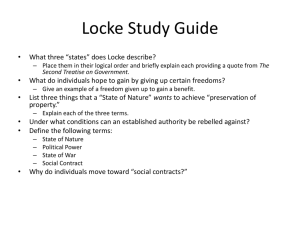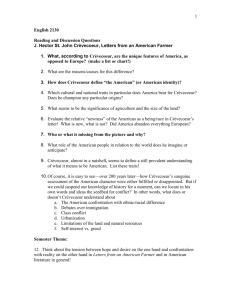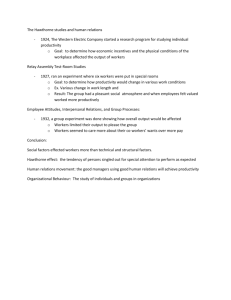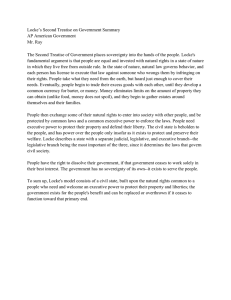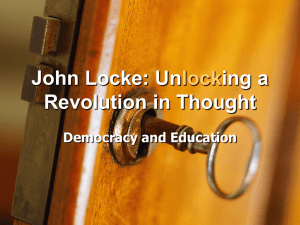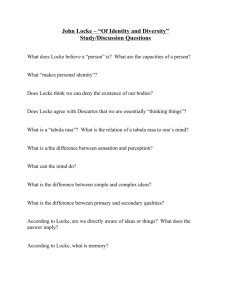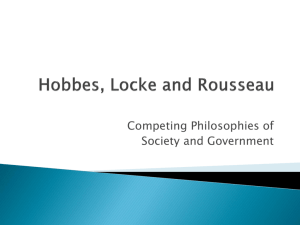Clearing, Cultivating, and American Manhood: Fries 1 Megan Fries
advertisement
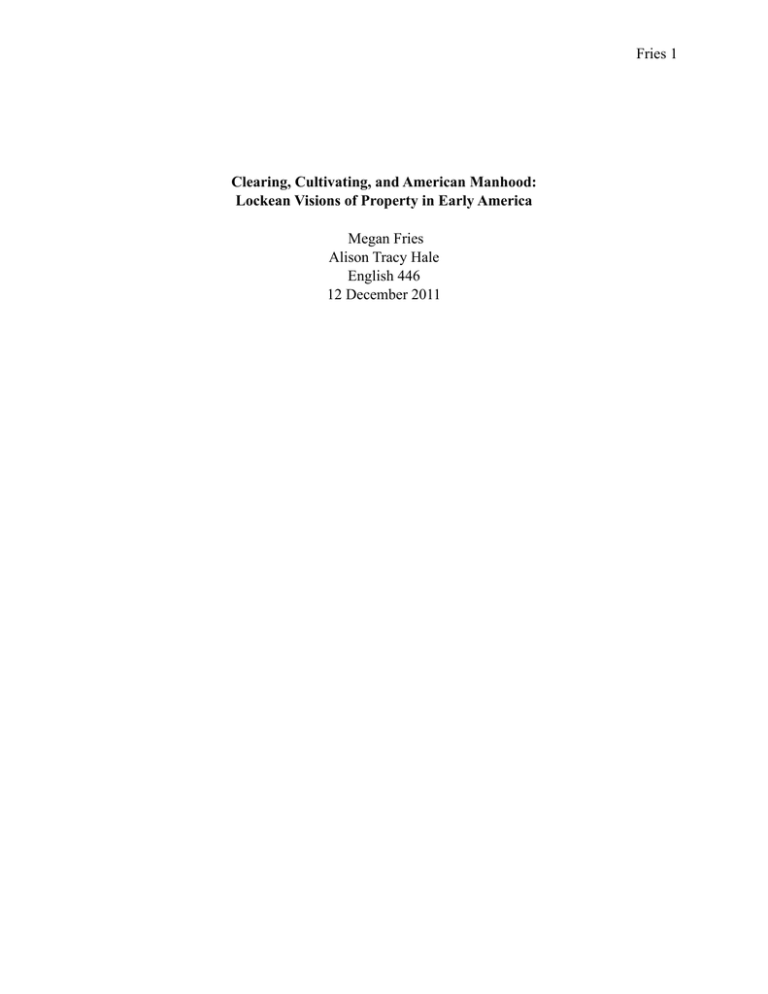
Fries 1 Clearing, Cultivating, and American Manhood: Lockean Visions of Property in Early America Megan Fries Alison Tracy Hale English 446 12 December 2011 Fries 2 For New World colonists, pre-Revolutionary English subjects, and citizens of the new American nation, the dominant ideology of private property and land-ownership changed little; Locke and other thinkers that New World colonists appropriated explained that a man owned private property when he “mixed” that land with his labor. Thus, any unoccupied land was waiting—and willing—to be subject to the loyal labors of the colonial farmer and liable to became “his.” Property-ownership, Locke argued, created civic society (Arneil 132), and thus to participate in that society—to have a “stake” in it—was to own and cultivate land. If someone was incapable of entering into this compact with the land—if one’s race or gender precluded a man or woman from cultivating land and thus owning it—that individual was justifiably excluded from the processes of civic society. Such a simple equation folded within it many colonists's anxieties and eventually informed the way the young nation would police its boundaries and justify the dispossession of American Indians. These ideologies—inherited from Old World thinkers—were brought to the New World by colonists, recycled by native-born Americans, and appropriated again by pre- and post-Revolutionary Americans to help shape identity, legitimate autonomy, and perform masculinity. Scholars have argued that identity is performed through space, and that, more specifically to Lockean philosophy, “[t]he formation of national identity is, in part, a meditation on the meanings and significance of land as property” (Blomley 122). Thus, when a man cultivated land, performing Lockean “labour” on it, he in turn created his place in society, his “social” sense-of-self. For America’s early writers, Lockean notions of property and cultivation are irrevocably linked to the new nation’s identity. Both Crèvecoeur’s Letters from an American Farmer and Hawthorne’s “Roger Malvin’s Burial” employ agrarian philosophy to imagine private property as a process of self-delineation and a Fries 3 conduit of manly autonomy. However, both narratives of early American and colonial life also reveal private property’s indebtedness to violence. Inherent in the myth of westward expansion and the cultivation of new, “fruitful” farmland is a blood-soaked landscape, the site of Native/ settler violence, ecological destruction, and political strife. John Locke wrote his Second Treatise of Government with an eye toward the landscape, governance, and the potential conflicts in England’s colonies across the Atlantic. The most well known section of Locke’s Treatise is his argument on property—what it is, how one acquires it, how one polices it, and what role it plays in the state. If every man, Locke assumes, “has a property in his own person” (28)—meaning that each man possesses his body, or himself—then the “labour of his body, and the work of his hands,” Locke argues, “are properly his” (28); “Whatsoever then he removes out of the state that nature hath provided, and left it in, he hath mixed his labour with, and joined to it something that is his own, and thereby make it his property” (28). Man “encloses it from the common” (30) and creates private property when he “mixes” his labor with the land. All outside of the demarcated spaces is vacuum domicillium, the neglected “waste land,” unoccupied land ready to enter the sphere of property (Arneil 141-142). Importantly, Locke often describes this labor in agrarian terms, using words like “tilled,” “sowed,” and “enclosed” to argue for a distinctly agrarian creation of property (Arneil 139). Ultimately, the order to exert labor on the land comes from God: “God and his reason commanded [man] to subdue the earth, i. e. improve it for the benefit of life, and therein lay out something upon it that was his own, his labour” (Locke 30). When men create property and police its boundaries, they subsequently create civil society (Arneil 132).1 1 Locke’s idea was not new. Stuart Banner explains that “[b]y the time the English were colonizing North America, many writers [even as far back as Greek and Roman philosophers] had used the connection between agriculture and property to develop a framework for understanding the development of societies” (35-36). Fries 4 Lockean notions of property, both its creation and its maintenance, became integral to American agrarian culture in the years surrounding and following the Revolution. Locke’s theories informed Jefferson’s democratic agrarianism, as he saw that “agrarian labour lay at the heart of property and in turn of civil society” (Arneil 192). 2 If labor fostered property, which in turn created civil society, then labor—specifically, the discipline of cultivation, land-clearing, and the demarcation of private property—made the citizen; a man was not wholly a man without his land, just as a civilization was not a civilization without private property. Some scholars call this logic Locke’s “creation-myth” (Blomley 122), as it defines the origin of civil society and subsequent nationhood. Taking up the mantle of Lockean notions of property, J. Hector St. John de Crèvecoeur a Frenchman turned “American farmer” shows how labor and cultivation are integral parts to this new man’s self-fashioning—that is, this new “American.” In his Letters from an American Farmer, Crèvecoeur’s narrative voice, writing under the pseudonym, James Hector St. John (which I will shorten to “St. John” to avoid confusion), addresses a friend from the Royal Society to describe the conditions of the colonies, men’s employment, and the landscape, but also to answer one central question: “What, then, is the American, this new man?” (Crèvecoeur 69). Fundamental to his answer is the role of farming, cultivation, land-clearing, and the life of a 2 I need to make clear here that my assumptions about Locke’s influence on Jeffersonian agrarianism (one I found also in Arneil) is a contested one. Scholars debate over the degree that Locke influenced early American democracy and philosophy. On one side of the argument is the belief that Lockean ideals were fundamental to America’s Declaration of Independence and Constitution while the other side argues that Lockean influence is negligible at best. This debate, however, does not dismantle my argument. It is not important to me that Lockean ideas influenced the founders’ political writings, but that Lockean terminology, imagery, and valuation of property informed the way early American writers wrote about men and the landscape they found themselves in. Whether or not they even read Locke is unimportant; the fact is that Lockean imagery endures in the early American and colonial consciousness as a compelling narrative of self-fashioning and helps to define uniqueness against the backdrop of Europe and, during the revolution, the villainous “Red Coats.” Fries 5 “humble,” and hopelessly inquisitive planter, the letters’s primary author (37). The French-born Crèvecoeur performs this new “American” identity through his “St. John” persona. Throughout his Letters, Crèvecoeur’s St. John underscores the importance of man’s relationship to land and argues that cultivation is a form of education. For him, property “confers” a “manly confidence” (94) and defines the “American farmer”: The instant I enter on my own land, the bright idea of property, of exclusive right, on independence, exalt my mind. Precious soil, I say to myself, by what singular custom of law is it that thou wast made to constitute the riches of the freeholder? What should we American farmers be without the distinct possession of that soil? (54) Property delineates sovereignty, rights, and is the “distinct possession” of American farmers. Importantly, its land-ownership that “confer” on men “the title of freemen” (69), and thus serve as integral processes to the creation of the autonomous self. Crèvecoeur’s St. John, however, extends the Lockean notions of property and selfhood even further, suggesting that men have “roots” and must be planted in appropriate environments, as they are inevitably “grounded” in the soil they take up. In his letter titled “What is an American?” St. John observes that “[w]e [men] are nothing but what we derive from the air we breathe, the climate we inhabit, the government we obey, the system of religion we profess, and the nature of our employment” (71). The environment, Crèvecoeur’s narrative voice continually argues, produces and enacts upon the man. For “[m]en are like plants; the goodness and labour of the fruit proceeds from the peculiar soil and exposition in which they grow” (71). Imagining that men are “rooted” in the spaces around them, St. John observes this phenomena in the various “gradations” of civilization one finds in this “new America.” There are those who dwell near the coast, and their consistent diet of seafood and the sight of the seascape “inspires them with a love Fries 6 of traffic, a desire of transporting produce from one place to another… which supply the place of labour” (71). The sea has a physical effect on the men “planted” on the rocky crags that stretch along the coastline, affecting their thoughts and “inspirations.” Then there is “the middle settlement,” which for St. John is the ideal one. In this middle ground, “the cultivation of the earth purifies [men]” (71). Though necessities of society do not allow for perfection, this portion of American industry is idyllic in comparison to the third option: the “fringe” territory, far from “the reach of government” (72) and the woodsmen that dwell within it. Though the woodsmen attempt to perform “the first labour of settlement, the mode of clearing the earth” (72) they succumb to “their native tempers” (72) and must be saved by more “industrious people” who will “convert [the woodsman’s] log-house into a convenient habitation, and rejoicing that the first heavy labours are finished, will change in a few years that hitherto barbarous country into a fine, fertile, well-regulated district. Such is our progress” (73). The lines of civilization, morality, productivity, and governance are drawn at the moment of “industrious” cultivation of the land, transforming it into “fertile” and “well-regulated” parcels of privately owned farms. In “Distresses of a Frontier Man,” the narrative voice takes on an unnamed persona that lives in a frontier settlement and must move even further into the wilderness, as the violence of the Revolution is too much for him and his family to bear. He speculates that he will seek out a certain Indian tribe and join its ranks, allowing his children to hunt and fish with the other children, his wife to live and work in the “wigwam,” while he will advise chiefs on trade and contribute to the tribe’s wealth through farming (200-227). Though this “Frontier Man” will soon begin his move west, his main concern is the education of his children. He has seen children become captives of tribes before, and noted that they returned to the settlements “so perfectly Fries 7 Indianized” that they were unrecognizable (213). The narrator affirms that it is the act of “hunting and fishing” that might thoroughly corrupt his children. Imagining the future “charm” of this lifestyle, the frontiersman explains that he plans to re-educate his children by “employ[ing] them in the labour of the fields” (219): “as long as we keep ourselves busy in tilling the earth, there is no fear of any of us becoming wild” (220). In his earlier letters, St. John describes hunters in unflattering terms, for he imagines that a life dependent on “the chase” creates “ferocious, gloomy, and unsocial” behavior” as every hunter must compete with his neighbor for food (76). Thus, the frontiersman believes that “industry and labour will be a sovereign preservative” (223) against the constant threat of “Indianization.” Taking up the same Lockean philosophy of property and American values of landownership and cultivation, Nathaniel Hawthorne created another fringe-dwelling persona in “Roger Malvin’s Burial.” However, Hawthorne’s story, published in 1832, does not wholeheartedly consider America the exceptional nation Crèvecoeur’s St. John imagines it to be, but rather undermines the founding mythos of the colonies; yet, like in Crèvecoeur’s Letters, Hawthorne employs Lockean models, imagery, and concerns to substantiate his portrait of early America. The story follows Reuben Bourne, a young man who leaves the wounded Roger Malvin in the wilderness after a violent encounter with Indians in the year 1725, promising to return. When he arrives back at his frontier settlement, however, Reuben lies about Malvin’s whereabouts and fate, marries the dead man’s daughter, and inherits Malvin’s wealth and farmland. Reuben’s flawed character—tainted by his inexplicable guilt over his “unredeemed vow” to “an unburied corpse [that] was calling to him, out of the wilderness” (98)—makes him a “neglectful farmer” (99); “while the lands of the other settlers became annually more fruitful, his Fries 8 deteriorated in the same proportion” (99). Though his inherited farm was “better stocked than most of the frontier establishments” (99) Reuben fails to fulfill his role as “husbandman” (99) to the land. After some time elapses, “he was finally a failed man” (99) and had only one option: to journey beyond the confines of his frontier village “and seek sustenance from the virgin bosom of the wilderness” (99). Reuben’s failure to cultivate the land and produce adequate yields— especially juxtaposed to St. John’s insistence that men of character till their property—signals a larger failure of character and an unwillingness or inability to participate in civic society. For if a fundamental economy in this new nation is man and his land, and that exchange yields legitimacy, Reuben fails to gain societal recognition. Thus, like the frontiersmen before him, Reuben seeks a better life—and more fruitful land for his “labors”—in the forest. Reuben’s relationship to the land inverts the exchange we encountered before in the Letters: while for Crèvecoeur, the land produced the man through labor, in Hawthorne the tainted, guilty man somehow taints his land, and thus is not “fruitful.” Thus Reuben, his wife, and his son Cyrus—a fifteen year old youth, “giving promise of a glorious manhood” (99)—step out into the “untrodden forest” (100). With their move comes a change in both Reuben and his son’s identity: they are no longer farmers, but “hunters,” as the narrator continually calls them. The men look to the forest with a “hunter’s eye” (101) and depart from Dorcas as “two hunters” while she prepares her “sylvan table” (104) for the meal they will bring home. As opposed to “a society of farmers,” hunters, as historian Stuart Banner highlights, do not inhabit “one location long enough to give rise to a claim of property” (157); or, to highlight more explicitly the Lockean connection, “[h]unters never mi[x] their labor with the land” (157). Thus, in the Lockean system of thought and the way Crèvecoeur re-imagined that Fries 9 philosophy of property in the fringe-territories of western America, hunters are not legitimate participants in this “new American” identity—they are too dependent on the unstable regions of the forest to call any one place “home.” As Reuben and his family push on, the forest becomes darker, more obscure, and more menacing. A few days into their journey, the “face of the country” is dominated “by swells of land, resembling huge waves of petrified sea” (102). While the land before their departure was parceled out, cleared, and tilled by farmers, this land resists demarcation, delineation, and instead “swells” in the “tangled and gloomy forest” (101). In his Letters, Crèvecoeur’s St. John meditated on an encounter he had with the sea in Nantucket, and imagery he employs complements the narrator’s description of the forest in “Roger Malvin’s Burial”: Can this wind which but a few days ago refreshed our American fields and cooled us in the shade be the same element which now and then so powerfully convulses the waters of the sea, dismasts vessels, causes so many shipwrecks and such extensive desolations? How diminutive does a man appear to himself when filled with these thoughts, standing as I did on the verge of the ocean! (164) St. John imagines the sea as an uncontrollable agent of destruction, as it “dismasts” and “powerfully convulses.” Unlike the “broad-lap” of America’s landscape, which yields up all one could desire if one is educated in what the land needs for cultivation, the ocean is unpredictable and instead “diminishes” man. St. John’s eyes are “involuntarily directed to the horizontal line of that watery surface, which is ever in motion and ever threatening destruction” (163). The sea, then, resists order or, in geography’s terms, confounds the “surveyor's eye” with its constant motion. Scholar of geography Nicholas Blomley (citing sources before him) locates an integral source of power in early colonial settlement in surveying and map making, as it was an “instrument… for establishing different political ideals [of royal colonies] by way of allocating Fries 10 land, their prime resource” (Kain and Baigent qtd. in Blomley 128). To resist the survey, too, is to resist land-parceling and thus the whole architecture of civic development. Thus the “swells of land” that resemble “petrified sea” that mark the new territory Reuben and his family have entered are like Crèvecoeur’s sea: they obscure and confound the surveyor’s scrutiny. Extending the logic of Crèvecoeur’s (or, rather St. John’s) claim that man is “rooted” in his environment, one can read Reuben’s impenetrable soul as a mirror-image of the unyielding wilderness: in the forest, Reuben was “[u]nable to penetrate the secret place of his soul, where his motives lay hidden” (103). Like the topography of the forest’s thick undergrowth, Reuben’s soul is illegible. The act of “penetration” through this obscurity—a kind of manly “labor” over previously uncultivated or unconquered spaces—is unavailable to him and Reuben cannot locate his senseof-self. Yet the family might overcome the environment—just as the forests the frontier establishments before them were when they were cleared—and thus the family, particularly Cyrus, marches on with optimism. Appropriating Biblical language to describe the family’s mythic future, Cyrus imagines that, at his death, he would be “the father of a race, the patriarch of a people, the founder of a mighty nation yet to be” (100). Going out into the forest to people this seemingly empty land with Nature’s “double wealth” (100), Cyrus and his family retrace the colonist’s first steps into the New World and echo their dreams of fortune, “godlike” posterity (101), and fruitful multiplying. Yet this myth ends with the death of Cyrus at the hands of his father. Both men, leaving the “sylvan table” to hunt game, pace the forest on the look-out for food. Reuben, “[p]erceiving the motion of some object behind a thick veil of undergrowth… fired, with the instinct of a hunter, and the aim of a practiced marksman” (104) and heard his kill Fries 11 fall; tragically, however, his bullet met his only son. With Reuben’s act, the line of inheritance is jolted, the dream of a patriarchy by his son destroyed. Importantly, one reason for Cyrus’s fate is that “impenetrable” “veil of undergrowth” which obscures Reuben’s sight; Reuben’s inability to “penetrate” the environment around him—an inability I noted before—leads, in this case, to the end of his patriarchal line. Near his son’s corpse are Roger Malvin’s bones, as Reuben followed some “supernatural” force to the very site of his oppressive guilt. It is here where Hawthorne’s narrator leaves Reuben, praying openly to God (107) over his son’s corpse and Malvin’s bones. Hawthorne’s story dismantles the myths behind America’s founding. The farmer-turnedhunter is not the innocent cultivator in Crèvecoeur’s Letters, but deeply complicit in the crimes of the frontier. Hawthorne’s story re-creates the colonists movement into the wilderness, however in this re-imagining, the colonists have literal “blood on their hands,” underscoring the violence inherent in westward expansion. In his postcolonial reading of “Roger Malvin’s Burial,” Manfred Mackenzie notes the significance of the story’s setting, “in the violence of European colonialists warfare in America” (467 author’s emphasis), arguing as other critics have that Reuben and his family retrace the colonial path into the wilderness. Ultimately, Mackenzie argues that “Hawthorne attempts ritually to exorcize his time of its (neocolonialist) violence” (461). For Mackenzie, Hawthorne “recites and rehearses the colonialist past, not in an antiquarian manner, and for the sake of reproducing or reinstalling it, but in order ultimately to concentrate, and so the more effectively ‘expel,’ its inherent violence” (461). By underscoring the ways Hawthorne “concentrates” on violence, Mackenzie argues that Hawthorne’s story seeks to redeem America’s tarnished past; thus Reuben must shed the blood of his son as a kind of sacrifice (Mackenzie 464). If Hawthorne’s story seeks “exoneration” from the colonial crimes of the past, it must do so Fries 12 by acknowledging the violence inherent in that history. In a wider sense, Hawthorne’s narrative and its ultimate critique—one that throws light on the role of the guilty-colonists in his move west—dismantles Lockean values. This “wilderness” is not the empty or “neglected” space Locke and the early colonists imagined, but littered with bones and tarnished with guilt. In fact, it is not simply empty but marked—stained, rather—with the bloody wounds from the “Indian wars” (88), the corpses of innocents (Cyrus), and full of the howls of “unburied corpses” (98). This land resists cultivation, for it is not an empty space but “swelling,” resisting survey and map-making, and serving as the site for violent confrontations between its “lawless” inhabitants. This revelation is not limited to “Roger Malvin’s Burial.” Though Crèvecoeur’s narrator, on the surface, believes this new “American farmer” to be untarnished, guilt-less, and “humble,” some moments in his Letters reveal that he is complicit in the violence that surrounds him. The farmer reveals his participation in this system of violence implicitly when he compares the death of innocents in war with that of grasses while clearing a field: “[virtue] soon affrighted, when ambition, thy great adversary, dictates, when war re-echoes the dreadful sounds and poor helpless individuals are mowed down by its cruel reapers like useless grass” (212). Here, “reaper” takes on its dual-meaning of both the tool for land-clearing and the personification of Death, yet in both readings is an axe-like tool that violently abridges life. “Useless grass” is reimagined as both the agrarian victim of industrious cultivation and the murdered innocents on the wrong side of war. While a seemingly small detail in a large collection of letters, this image refracts larger concerns surrounding the creation of private property and its maintenance; like Hawthorne, Crèvecoeur’s Letters reveal the mark of violence on the system of private property. Fries 13 Blomley’s work on “the geographies of violence” argues that at the heart of the project to create private property and police its boundaries is violence: “violence plays an integral role in the legitimation, foundation, and operation of a regime of private property” (121). If, as Locke argued, property creates civic society then it also prompts the creation of law (Blomley 123). Systems of law “requir[e] the construction of a constitutive outside with reference to, and against which, it sets itself apart. And violence is integral to that construction” (123). The maintenance of colonial settlements and frontier establishments, therefore, must employ violence to demarcate and maintain its boundaries. Violence, therefore, is “central to American national identity, given the necessarily violent nature of colonial settlement” (Foote qtd. in Blomley 126). The Lockean philosophy of labor applied to land—the foundational understanding for the creation of private property, which in turn prompts civilization—is a sanitized vision of the process, one that christens man as an agent of God to realize his expansive empire of demarcated farms, fields, cities, and metropolises. This claims is, of course, nothing new. Yet the manner by which both Crèvecoeur’s Letters and “Roger Malvin’s Burial” articulate man’s relationship to land—whether knowingly or unknowingly—reveals the endurance of the Lockean philosophy, its continual resurfacing in American literature, and its indebtedness to violence. Locke’s model is untainted by that bloodshed—for God Himself calls man to demarcate “neglected” lands and call them his own—and thus is an ultimately sanitized vision of the real landscape of colonial and “postcolonial” America. Imbedded in the logic of Lockean property rights and subsequent Jeffersonian agrarianism is a justification for colonialism. Locke’s philosophies and agrarian ideals were part of a larger argument that dispossessed American Indians of their lands and helped to justify that Fries 14 seizure in the years following the revolution. Yet marks of that violence remained. Though she was writing about Jefferson’s Notes on the State of Virginia, Catherine Holland argues that “[n]ature is a means by which America may be made intelligible as a nation” (191). Crèvecoeur insistence that the landscape of America—the space and soil that spread across it—is integral to America’s self-fashioning complements Holland’s claim, for Crèvecoeur shows how the American came to be through land cultivation. Hawthorne’s story—even if it, as Mackenzie argues, attempts to purge America’s past violence—shows too how man’s relationship to nature defined early American nationhood, manly autonomy, and patriarchy. Integral to that definition is Locke’s theory on property, which imagines the self “rooted” in its cultivated lands. Yet that process by which nature become civilization, the Lockean “labour” that restricted land to a sole individual, is, as these authors suggest, a fundamentally violent one. Fries 15 Works Cited Arneil, Barbara. John Locke And America: The Defence of English Colonialism. Oxford: Clarendon Press, 1996. Banner, Stuart. How the Indians Lost Their Land: Law and Power on the Frontier. Cambridge: Belknap Press, 2005. Blomley, Nicholas. “Law, Property, and the Geography of Violence: The Frontier, the Survey, and the Grid.” Annals of the Association of American Geographers 93.1 (2003): 121-141. Crèvecoeur, J. Hector St. John de. Letter from an American Farmer and Sketches of Eighteenth Century America. Ed. Albert E. Stone. New York: Penguin, 1986. Hawthorne, Nathaniel. “Roger Malvin’s Burial.” Tales and Sketches. New York: Library of America, 1996. 88-107. Locke, John. “The Second Treatise of Government. An Essay Concerning The True Original, Extent, and End of Civil Government.” The Selected Political Writing of John Locke. Ed. Paul E. Sigmund. New York: Norton, 2005. 17-125. Mackenzie, Manfred. “Hawthorne’s ‘Roger Malvin’s Burial’: A Postcolonial Reading.” New Literary History 27.3 (1996): 459-472.
